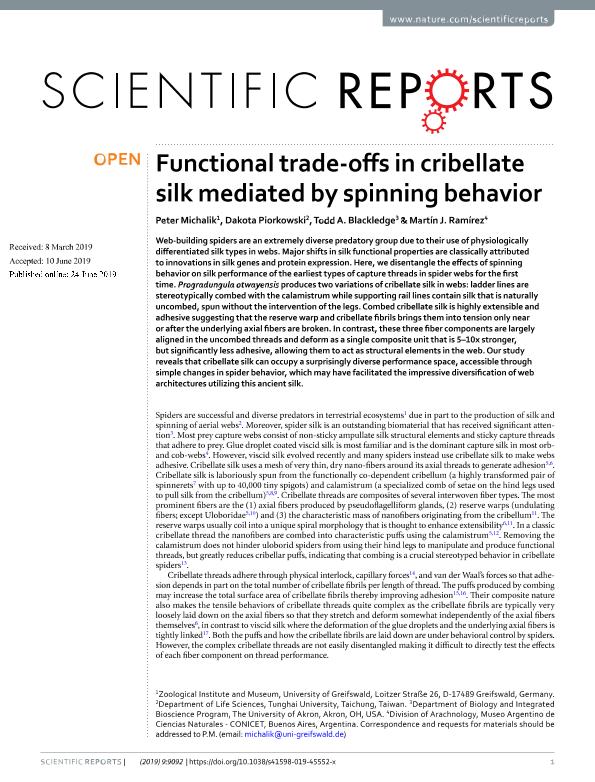Mostrar el registro sencillo del ítem
dc.contributor.author
Michalik, Peter

dc.contributor.author
Piorkowski, Dakota
dc.contributor.author
Blackledge, Todd A.
dc.contributor.author
Ramirez, Martin Javier

dc.date.available
2020-12-17T16:56:02Z
dc.date.issued
2019-12
dc.identifier.citation
Michalik, Peter; Piorkowski, Dakota; Blackledge, Todd A.; Ramirez, Martin Javier; Functional trade-offs in cribellate silk mediated by spinning behavior; Nature Publishing Group; Scientific Reports; 9; 1; 12-2019; 1-6
dc.identifier.uri
http://hdl.handle.net/11336/120782
dc.description.abstract
Web-building spiders are an extremely diverse predatory group due to their use of physiologically differentiated silk types in webs. Major shifts in silk functional properties are classically attributed to innovations in silk genes and protein expression. Here, we disentangle the effects of spinning behavior on silk performance of the earliest types of capture threads in spider webs for the first time. Progradungula otwayensis produces two variations of cribellate silk in webs: ladder lines are stereotypically combed with the calamistrum while supporting rail lines contain silk that is naturally uncombed, spun without the intervention of the legs. Combed cribellate silk is highly extensible and adhesive suggesting that the reserve warp and cribellate fibrils brings them into tension only near or after the underlying axial fibers are broken. In contrast, these three fiber components are largely aligned in the uncombed threads and deform as a single composite unit that is 5–10x stronger, but significantly less adhesive, allowing them to act as structural elements in the web. Our study reveals that cribellate silk can occupy a surprisingly diverse performance space, accessible through simple changes in spider behavior, which may have facilitated the impressive diversification of web architectures utilizing this ancient silk.
dc.format
application/pdf
dc.language.iso
eng
dc.publisher
Nature Publishing Group

dc.rights
info:eu-repo/semantics/openAccess
dc.rights.uri
https://creativecommons.org/licenses/by/2.5/ar/
dc.subject
Silk
dc.subject
Material sciences
dc.subject
Behavior
dc.subject.classification
Zoología, Ornitología, Entomología, Etología

dc.subject.classification
Ciencias Biológicas

dc.subject.classification
CIENCIAS NATURALES Y EXACTAS

dc.title
Functional trade-offs in cribellate silk mediated by spinning behavior
dc.type
info:eu-repo/semantics/article
dc.type
info:ar-repo/semantics/artículo
dc.type
info:eu-repo/semantics/publishedVersion
dc.date.updated
2020-11-26T17:53:24Z
dc.identifier.eissn
2045-2322
dc.journal.volume
9
dc.journal.number
1
dc.journal.pagination
1-6
dc.journal.pais
Reino Unido

dc.journal.ciudad
Londres
dc.description.fil
Fil: Michalik, Peter. ERNST MORITZ ARNDT UNIVERSITÄT GREIFSWALD (UG);
dc.description.fil
Fil: Piorkowski, Dakota. Tunghai University; China
dc.description.fil
Fil: Blackledge, Todd A.. University of Akron; Estados Unidos
dc.description.fil
Fil: Ramirez, Martin Javier. Consejo Nacional de Investigaciones Científicas y Técnicas. Oficina de Coordinación Administrativa Parque Centenario. Museo Argentino de Ciencias Naturales "Bernardino Rivadavia"; Argentina
dc.journal.title
Scientific Reports
dc.relation.alternativeid
info:eu-repo/semantics/altIdentifier/doi/http://dx.doi.org/10.1038/s41598-019-45552-x
dc.relation.alternativeid
info:eu-repo/semantics/altIdentifier/url/https://www.nature.com/articles/s41598-019-45552-x
Archivos asociados
